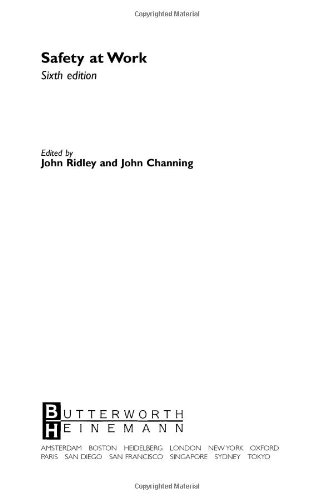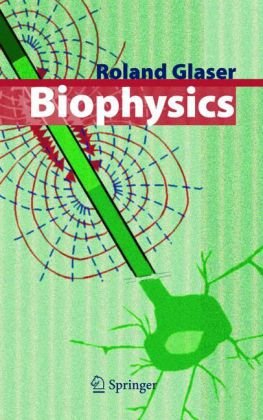John Channing MSc(Safety) MSc(Chemistry) FIOSH RSP, John Ridley BSc CEng MIMechE FIOSH DMS0750654937, 9780750654937
Table of contents :
Safety at Work……Page 3
Contents……Page 5
Foreword……Page 17
3.8.4 Ergonomics Ò has designs on you……Page 0
Preface to sixth edition……Page 19
Preface to first edition……Page 23
Contributors……Page 25
I Law……Page 27
1.1.3 Some possible actions arising from the incident……Page 29
1.1.5 Criminal and civil law……Page 30
1.1.6 Branches of law……Page 31
1.1.8 The courts……Page 33
1.1.9 Judicial precedent……Page 43
1.1.10 Court procedure……Page 44
1.1.11 Identity of court personnel……Page 50
1.1.12 Employment Tribunals……Page 52
1.1.13 European Community Courts (ECJ)……Page 53
1.1.15 Sources of English law……Page 55
1.1.16 Legislation……Page 56
1.1.17 Safety legislation before the Health and Safety at Work etc. Act……Page 63
1.1.18 Safety legislation today……Page 64
1.1.19 Principles developed by the courts……Page 67
1.2.1 The Health and Safety at Work etc. Act 1974……Page 75
1.2.3 The Fire Precautions Act 1971……Page 85
1.2.5 The Environmental Protection Act 1990……Page 87
1.2.7 The Public Health Act 1936……Page 88
1.2.10 Crown premises……Page 89
1.2.11 Subordinate legislation……Page 90
1.3.2 The Robens Report1……Page 93
1.3.3 Delegation of law-making powers……Page 94
1.3.4 Legislative framework for health and safety……Page 95
1.3.5 Self-regulation……Page 96
1.3.6 Goal-setting legislation……Page 97
1.3.7 European Union……Page 98
1.3.8 European standards……Page 101
1.3.10 Social expectations……Page 103
1.3.12 Political influences……Page 104
1.3.13 Roles in health and safety……Page 105
1.3.15 Quality culture……Page 106
1.3.17 Risk assessments……Page 107
1.3.18 Conclusion……Page 108
1.4.1 Contracts……Page 110
1.4.2 Contracts of employment……Page 113
1.4.3 Employment legislation……Page 114
1.4.4 Law of sale……Page 116
1.4.5 Specialised legislation affecting occupational safety advisers……Page 118
1.5.2 Employment law……Page 122
1.5.3 Discrimination……Page 124
1.5.4 Disciplinary procedures……Page 131
1.5.5 Dismissal……Page 133
1.5.6 Summary……Page 143
1.6.1 Fair conditions of contract……Page 145
1.6.3 Product safety……Page 153
1.6.4 Product liability……Page 158
1.6.5 Misleading advertising……Page 160
1.6.6 Exclusion clauses……Page 161
1.6.8 Stop now orders……Page 164
1.6.9 Consumer redress……Page 165
7 Insurance cover and compensation……Page 167
1.7.3 Public Liability insurance……Page 176
1.7.4 Investigation, negotiation and the quantum of damage……Page 177
1.7.5 General……Page 181
1.8.1 The common law and its development……Page 182
1.8.2 The law of tort……Page 183
1.8.4 Supply of goods……Page 187
1.8.7 Health and Safety at Work etc. Act 1974……Page 191
1.8.8 Defences to a civil liability claim……Page 192
1.8.9 Volenti non fit injuria……Page 193
1.8.11 Assessment of damages……Page 194
1.8.12 Fatal accidents……Page 196
II The management of risk……Page 199
2.1.1 Introduction……Page 201
2.1.2 The components of risk……Page 203
2.1.3 Strategies to control risk……Page 206
2.1.4 Risk management in the 21st century……Page 210
2.2.1 Principles of action necessary to prevent accidents……Page 213
2.2.2 Definitions of hazard, risk and danger……Page 214
2.2.3 Risk management……Page 216
2.2.4 Loss control……Page 219
2.2.5 Degrees of hazard……Page 223
2.2.6 Accident causation models……Page 224
2.2.7 Accident prevention: legal, humanitarian and economic reasons for action……Page 227
2.3.1 Introduction……Page 231
2.3.2 Organisation structure models……Page 232
2.3.3 Roles and responsibilities……Page 236
2.3.4 Work groups……Page 238
2.3.5 Organisational theory……Page 240
2.3.6 Organisational techniques……Page 243
2.3.7 Culture……Page 246
2.3.8 Potential problems……Page 247
2.3.9 The role of specialists in the organisation……Page 250
2.3.10 Conclusion……Page 251
2.4.1 Risk identification, assessment and control……Page 253
2.4.2 Job safety analysis……Page 259
2.4.3 System safety……Page 264
2.4.4 Systems theory and design……Page 266
2.4.6 Fault tree analysis……Page 269
2.4.7 Probabilistic risk assessments……Page 270
2.4.8 Health and safety in design and planning……Page 272
2.4.9 Quality, Environment, Safety and Health Management Systems ( QUENSH)……Page 274
2.4.10 Use of data on accidents……Page 276
2.4.11 Maintenance systems and planned maintenance……Page 277
2.4.12 Damage control……Page 278
2.4.13 Cost-effectiveness of risk management……Page 279
2.4.14 Performance evaluation and appraisal……Page 283
2.4.15 Loss control profiling……Page 285
2.5.2 Types of accident and incident data……Page 289
2.5.3 Collection of accident and incident data……Page 293
2.5.5 The use of accident and incident data……Page 297
2.5.6 Epidemiological analysis……Page 305
2.5.7 Accident investigation……Page 307
2.5.8 Accident and incident data and risk assessment data……Page 318
2.5.9 The use of computers……Page 320
Appendix. UK requirements for reporting accidents and incidents……Page 325
2.6.1 Introduction……Page 330
2.6.2 Legal obligations……Page 331
2.6.3 Generic safety management……Page 332
2.6.4 Implementing a regulation within a safety management system……Page 336
2.6.5 Safety management and housekeeping……Page 341
2.6.6 Assessment techniques……Page 345
2.6.7 Proprietary audit systems……Page 348
2.6.8 Safety systems and incidents……Page 350
2.6.9 Learning organisations……Page 351
2.6.10 Safety management systems in small organisations……Page 353
2.6.11 Conclusion……Page 354
2.7.1 Introduction: What does this chapter try to do?……Page 356
2.7.2. Individuals as controllers of danger……Page 358
2.7.3 Behavioural science and the human information processor……Page 361
2.7.4 Individual behaviour in the face of danger……Page 377
2.7.5 Change……Page 399
2.7.6 Conclusion……Page 411
2.8.1 Introduction……Page 415
2.8.2 Behaviour modification for employees……Page 417
2.8.3 Behaviour modification for managers and supervisors……Page 428
2.8.4 Applying behaviour concepts to incident investigation……Page 434
2.8.6 Risk, behaviour, leadership and commitment……Page 436
2.8.7 Behaviour modification processes: the hazards……Page 438
2.8.8 Behaviour and safety culture……Page 439
2.8.9 Conclusion……Page 441
III Occupational health and hygiene……Page 445
3.1.2 History……Page 447
3.1.4 Overseas developments……Page 450
3.1.5 Risks to health at work……Page 451
3.1.6 Occupational hygiene……Page 452
3.1.7 First aid at work……Page 453
3.1.8 Basic human anatomy and physiology……Page 454
3.1.9 Cancer and other problems of cell growth……Page 469
3.1.11 Factors determining the effect of substances in the body……Page 471
3.1.12 The assessment of risk to health……Page 472
3.2.2 Toxicology……Page 473
3.2.3 Diseases of the skin……Page 477
3.2.4 Diseases of the respiratory system……Page 480
3.2.5 Diseases from metals……Page 486
3.2.6 Pesticides……Page 490
3.2.7 Solvents……Page 491
3.2.8 Gassing……Page 495
3.2.9 Oxygen deficiency……Page 497
3.2.10 Occupational cancer……Page 499
3.2.11 Physical agents……Page 501
3.2.12 Ionising radiations……Page 502
3.2.13 Noise-induced hearing loss……Page 505
3.2.15 Work related upper limb disorders (WRULD)……Page 508
3.2.16 Diseases due to micro-organisms……Page 509
3.2.17 Psycho-social disorders……Page 513
3.2.18 Target organs……Page 514
3.3.1 Recognition……Page 518
3.3.2 Evaluation……Page 519
3.3.3 Control measures……Page 538
3.3.4 Summary……Page 548
3.4.2 Structure of matter1Ò……Page 550
3.4.4 Ionising radiation4……Page 551
3.4.5 Biological effects of ionising radiation4–……Page 552
3.4.6 Quantities and units……Page 553
3.4.7 Basic principles of radiological protection……Page 554
3.4.8 Legal requirements……Page 559
3.4.9 National Radiological Protection Board……Page 562
3.4.11 Non-ionising radiation……Page 563
3.5.1 What is sound?……Page 569
3.5.2 Other terms commonly found in acoustics……Page 572
3.5.4 The sound level meter……Page 576
3.5.5 The ear……Page 578
3.5.6 The equivalent noise level……Page 579
3.5.7 Community noise levels……Page 580
3.5.8 Work area noise levels……Page 581
3.5.9 Noise control techniques……Page 582
3.5.10 Vibration……Page 590
3.5.11 Summary……Page 592
6 Workplace pollution, heat and ventilation……Page 594
3.6.1 Methods of assessment of workplace air pollution……Page 595
3.6.2 Measurement of the thermal environment……Page 598
3.6.3 Standards for workplace environments……Page 599
3.6.4 Ventilation control of a workplace environment……Page 601
3.6.5 Assessment of performance of ventilation systems……Page 603
3.7.2 The eye……Page 607
3.7.3 Eye conditions……Page 608
3.7.4 Definitions6……Page 609
3.7.5 Types of lighting……Page 611
3.7.6 Illuminances……Page 612
3.7.7 Factors affecting the quality of lighting……Page 614
3.7.8 Use of light measuring instruments……Page 617
3.8.1 Introduction……Page 620
3.8.2 Ergonomics defined……Page 621
3.8.5 Ergonomic concepts……Page 624
3.8.6 Managing ergonomic issues in the workplace……Page 631
3.8.7 Work-related upper limb disorders (WRULD)……Page 632
3.8.8 Back issues……Page 635
3.8.9 Managing the ergonomics of disability……Page 636
3.8.10 Legal requirements……Page 637
3.8.11 Conclusion……Page 640
3.9.1 Introduction……Page 643
3.9.2 Physiology……Page 644
3.9.3 Working environment……Page 657
3.9.4 Manual handling……Page 664
3.9.5 Repetitive actions……Page 665
3.9.7 Controls and indicators……Page 666
3.9.8 Noise and vibrations……Page 668
3.9.9 Stress……Page 669
3.9.10 Display screen equipment (DSE)……Page 670
3.9.11 Signs and signals……Page 671
3.9.12 Coda……Page 672
IV Workplace safety……Page 675
4.1.2 Structure of matter……Page 677
4.1.3 Properties of chemicals……Page 679
4.1.4 Physical properties……Page 683
4.1.5 Energy and work……Page 689
4.1.6 Mechanics……Page 690
4.1.7 Strength of materials……Page 691
4.1.8 Modes of failure……Page 693
4.1.10 Hydraulics……Page 694
4.1.11 Summary……Page 695
4.2.2 Basic fire technology……Page 697
4.2.3 Fire hazards and their control……Page 700
4.2.4 Fire alarms and detectors……Page 704
4.2.5 Classification of fires……Page 711
4.2.6 Portable fire-fighting equipment……Page 714
4.2.7 Fixed fire-fighting equipment……Page 721
4.2.8 Fire safety signs……Page 728
4.2.9 Means of escape in case of fire……Page 729
4.2.10 Fire engineering……Page 732
4.2.11 Fire protection measures……Page 734
4.2.12 Legal requirements……Page 737
4.2.13 Fire risk assessment……Page 742
4.2.14 Access and facilities for the fire brigade……Page 745
4.2.15 Fire terminology……Page 746
4.3.1 Introduction……Page 753
4.3.2 Strategy for selecting safeguards……Page 760
4.3.3 Safeguarding techniques……Page 763
4.3.4 Powered trucks……Page 775
4.3.5 Lifting equipment……Page 780
4.3.6 Pressure systems……Page 786
4.3.7 Coda……Page 792
4.4.1 Alternating and direct currents……Page 795
4.4.2 Electricity supply……Page 796
4.4.3 Statutory requirements……Page 798
4.4.5 Electrical accidents……Page 799
4.4.6 The basic electrical circuit……Page 800
4.4.7 Dangers from electricity……Page 801
4.4.8 Protective means……Page 804
4.4.9 Competence……Page 807
4.4.11 Static electricity……Page 808
4.4.12 Use of electricity in adverse or hazardous environments……Page 811
4.4.13 Electrical equipment in flammable atmospheres……Page 812
4.4.15 Residual current devices……Page 815
4.4.17 Conclusion……Page 816
4.5.1 Introduction……Page 819
4.5.3 Pressure systems……Page 820
4.5.4 Lifting equipment……Page 826
4.5.5 Power presses and press brakes……Page 832
4.5.6 Local exhaust ventilation……Page 834
4.5.7 Electrical equipment and installations……Page 836
4.5.8 Other considerations……Page 837
4.5.9 Conclusion……Page 840
4.6.1 Construction accidents……Page 845
4.6.2 Safe working in the industry……Page 846
4.6.3 Site hazards……Page 855
4.6.4 Access……Page 860
4.6.5 The Lifting Operations and Lifting Equipment Regulations 1998……Page 862
4.6.6 Welfare facilities……Page 867
4.6.7 Other relevant legislation……Page 868
4.7.2 Chemical data……Page 876
4.7.3 Source of information……Page 877
4.7.4 Risk assessments……Page 878
4.7.5 Minimising the risk……Page 882
4.7.6 Legislative requirements……Page 886
4.7.7 Storage of substances……Page 893
4.7.8 Transport……Page 897
4.7.9 Plant and process design……Page 898
4.7.10 Further safety studies……Page 907
4.7.12 Safe systems of work……Page 908
4.7.13 Laboratories……Page 910
4.7.14 Emergency procedures……Page 913
4.7.15 Conclusions……Page 914
V The environment……Page 917
5.1.1 Introduction……Page 919
5.1.2 Environmental predictions……Page 920
5.1.3 Sustainable development……Page 921
5.1.4 Environmental hazards……Page 924
5.1.5 Evaluating environmental risks……Page 926
5.1.6 Environmental control strategies……Page 930
5.1.7 Conclusion……Page 932
5.2.1 Introduction……Page 934
5.2.2 Establishing an environmental management system……Page 935
5.2.4 Conclusions……Page 945
5.3.1 Introduction……Page 947
5.3.2 Waste authorities……Page 948
5.3.3 National waste strategies……Page 949
5.3.4 Defining waste……Page 950
5.3.5 The waste hierarchy……Page 952
5.3.6 Waste management in practice……Page 953
EMERGENCY SPILLAGE PROCEDURE……Page 961
5.3.7 Waste minimisation……Page 968
5.3.8 The cost of failure to manage waste effectively……Page 978
5.3.9 Conclusion……Page 979
5.4.2 Chemical data……Page 982
5.4.4 The Environmental Protection Act 1990 (EPA)……Page 983
5.4.5 Minimising environmental harm……Page 988
5.4.6 Air pollution: control measures and abatement techniques……Page 991
5.4.7 Monitoring atmospheric pollution……Page 993
5.4.8 Control of water pollution……Page 996
5.4.9 Groundwater pollution15……Page 998
5.4.10 Waste disposal and duty of care……Page 999
5.4.12 Environmental management systems……Page 1008
5.4.13 Conclusion……Page 1010
5.5.1 Introduction……Page 1012
5.5.2 Environmental issues……Page 1013
5.5.3 The environment and the media……Page 1019
5.5.4 The global impact of environmental issues……Page 1020
5.5.5 Ethical investing and green procurement……Page 1021
5.5.6 Increasing environmental legislation, controls and public reporting……Page 1022
5.5.7 End-of-pipe control……Page 1023
5.5.8 Polluter pays……Page 1024
5.5.9 Producer or shared responsibility……Page 1025
5.5.10 Environmental management system (EMS) and sustainable development……Page 1026
5.5.11 Corporate social responsibility……Page 1027
Appendices……Page 1031
The Institution of Occupational Safety and Health……Page 1033
Reading for Part I of the NEBOSH Diploma examination……Page 1034
List of abbreviations……Page 1035
Organisations providing safety information……Page 1041
List of Statutes, Regulations and Orders……Page 1043
List of Cases……Page 1051
Index……Page 1057







Reviews
There are no reviews yet.